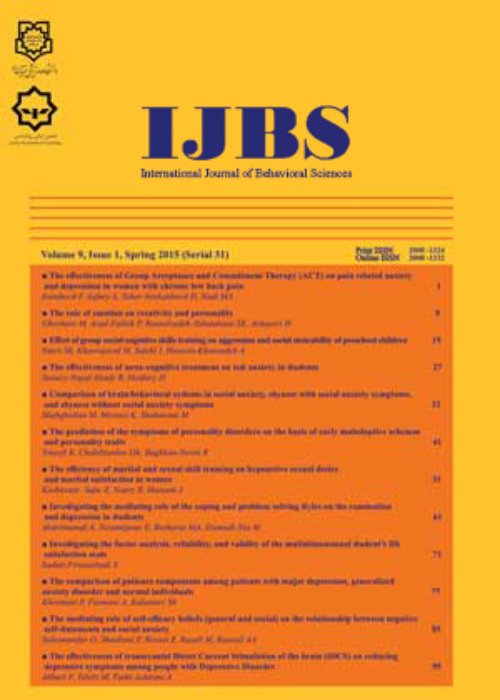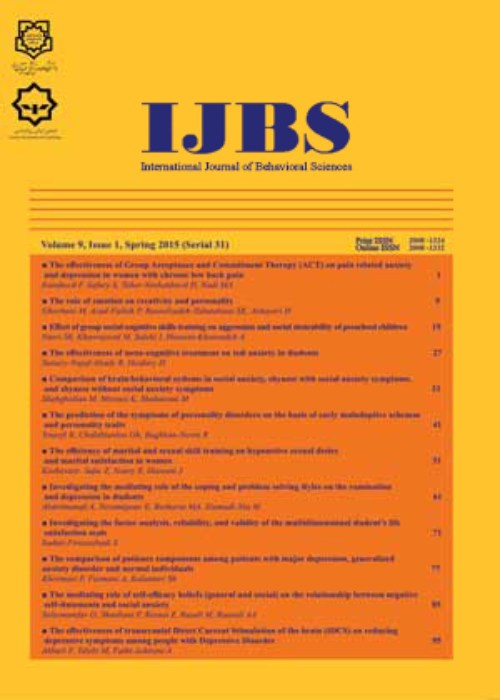فهرست مطالب

International Journal of Behavioral Sciences
Volume:16 Issue: 3, Autumn 2022
- تاریخ انتشار: 1401/09/19
- تعداد عناوین: 8
-
-
Pages 170-176IntroductionAbnormalities occurring in the glutamatergic system during obsessive-compulsive disorder, as a debilitating mental health condition, have been thus far illustrated. However, open-label and clinical trials of ketamine augmentation in limited subjects with treatment-refractory Obsessive-Compulsive Disorder (OCD) have not documented very persistent anti-OCD effects. Therefore, this controlled trial was conducted on patients with treatment-refractory OCD to evaluate the therapeutic efficacy of ketamine augmentation, as a non-competitive N-methyl-D-aspartate receptor antagonist.MethodIn this prospective, double-blind, placebo-controlled clinical trial, a total number of 30 subjects with treatment-refractory OCD were randomly assigned to either the group with the intravenous infusion of ketamine 0.5 mg/kg or the one receiving a dose of midazolam 0.045 mg/kg as an active placebo over 40 min. The OCD Visual Analog Scale (OCD-VAS) and the Yale-Brown Obsessive-Compulsive Scale (Y-BOCS) were also performed at mid-infusion, 1 h later, and on the 1st, 3rd, 5th, 7th, 14th, 21st, and 28th days following it.ResultsThe mean OCD-VAS score in the group taking ketamine was lower than the value in the group receiving midazolam during the treatment. Even though these differences were not significant, the trend of changes in each study group was considerable (P=0.001). Response to treatment in the ketamine group was significantly higher than the midazolam group on the third day of treatment (P=0.042).ConclusionAccording to the findings of the present study, it can be stated that the adjuvant therapy with ketamine could bring significant positive effects on the third day of the treatment.Keywords: Glutamate, Ketamine, Midazolam, Obsessive-compulsive disorder, Clinical trial
-
Pages 177-182IntroductionThis study aims to investigate the relationship between self-control and forgiveness with the duration of marriage in couples living in Zanjan, Iran.MethodFor this purpose, 384 individuals who had been married for one to four years were selected by available sampling method during 2021. Tangney Self-Control (2004) and Ehteshamzadeh Interpersonal Forgiveness (2009) Questionnaires were used to collect the data. Pearson correlation coefficient (R), one-way analysis of variance, and LSD post hoc test were utilized for data analysis.ResultsFindings revealed a significant relationship between self-control and forgiveness in couples with one, two, three and four years (r = 0.29, 0.44, 0.47, 0.53) of marriage duration. Considering this, as the duration of marriage increases, the relationship between self-control and forgiveness also increases in couples. Therefore, self-control and forgiveness are effective in increasing the duration of marriage. In addition, in terms of marriage duration, there is no significant difference between couples' self-control, while in terms of marriage duration, a significant difference was observed between couples' forgiveness.ConclusionAccording to the findings of this study, paying attention to the self-control and forgiveness skills of couples and empowering them to increase these skills can provide a good basis for experiencing a durable marriage.Keywords: self-control, forgiveness, Marriage Durability
-
Pages 183-190IntroductionDuring the COVID-19 epidemic, many people around the world committed suicide and self-harm due to psychological disorders. For this purpose, studies on the prevalence of self-harm and suicide attempt during COVID-19 have been reviewed in the present study.MethodIn this review study the following specialized keywords were searched between 2020 (May) and 2022 (January) in English databases such as Google Scholar, ISI, Scopus, Science Direct, and PubMed: suicide, suicidal thoughts, suicide attempts, self-harm, self-injury, self-harm deliberate, COVID-19.ResultsThe results showed that the prevalence of suicide (2%-71.9%) and self-harm (2%-47.6%) during COVID-19 has increased significantly compared to the past. Economic problems, young age, being a woman, unemployment, family problems, loneliness, and psychological distress were among the factors that aggravated self-harm and suicide attempt during COVID-19. In contrast, social support, resilience, psychological resilience, and spiritual health reduced suicidal thoughts and behaviors.ConclusionAccording to the obtained results, lack of access to a psychologist was one of the important reasons for thoughts and behaviors related to self-harm and suicide during COVID-19 epidemic. For this reason, it is necessary for psychological centers, hospitals, and related organizations to take measures in order to increase tele-mental health services.Keywords: COVID-19, Suicide, self-harm, Systematic review
-
Pages 191-197Introduction
Many unpredictable situations require the use of cognitive and emotional resources, but stress prevents adaptation to the situation and cognitive readiness claims to create this adaptation. Therefore, the aim of this research is to compare the brain wave patterns with different cognitive readiness in two situations with and without stress.
MethodThe present research is of a causal-comparative that the statistical population included military personnel, who volunteered to participate in the research. The participants included 42 people who were placed in two groups of low and high cognitive readiness. The level of cognitive readiness of all people was done using situation simulation and Virtual Reality. The electroencephalography of subjects was recorded in two situations. Data were analyzed using the MANCOVA test.
ResultsBrain waves have significant differences between the two groups, and the intensity of the waves in the group with low cognitive readiness is more than the other group, which shows brain activity to react to stress in the group with low cognitive readiness is more than the other group (p<0.01).
ConclusionPhysiological and neurological indicators can be considered important for military applications. This is because finding physiological characteristics with sufficient accuracy can be reliable evidence for selecting military personnel or checking the effectiveness of psychological.
Keywords: electroencephalography, brain, psychological stress -
Pages 198-203IntroductionDespite substantial evidence showing that diabetes and psychiatric disorders influence each other in multiple ways, these two issues remain largely unstudied in Rwanda. This study therefore, was aimed to determine the predictors of depression, and the moderating factors of its association with glycaemic level.MethodA convenient sample of 96 patients with Type 2 Diabetes (T2D) (MA=55, SD=11.63) from Butare University Teaching Hospital (CHUB) was selected for participation in this institutional based cross-sectional study. Data were collected using the standardized measures of mental disorders and social support, and analyzed using the IBM SPSS version 28.ResultsResults indicated that 83.34% of the sample had clinical levels of moderate to severe depression. Its associated factors were glycemic levels (b=.74, p˂.001), psychiatric symptoms (b=.46, p˂.05), gender and self-esteem (b=-.25, p˂.05). Notably, self-esteem (b=.79, p =.0001), psychiatric symptoms (b=.90, p=.000), gender (b=-.32, p=.001), and poverty (b=.38, p=.00001) were significant moderators of the associations between glycemic level and depression symptoms.ConclusionOur findings highlight the factors of depression, and the moderators of the relationship between glycemic level and depression among patients with T2D. These findings will inform both endocrinologist and mental health professionals about the associations that should be monitored, and issues to be addressed to avoid worsening of glycemic control and depression.Keywords: Diabetes Mellitus, Prevalence, depression, mental disorders
-
Pages 204-211IntroductionMany people with Attention Deficit/Hyperactivity Disorder (ADHD) suffer from comorbidity of depression or anxiety. Also, in ADHD patients Mind-Wandering (MW) and lack of motivation are common. This study aimed to examine the mediating role of motivation and MW in the relationship between depression and anxiety with ADHD symptoms.MethodThis research was a correlational study which was run within the Structural Equation Modelling framework. The statistical population consisted of all university students of Isfahan in 2020-2021 with ADHD symptoms, of whom 211 were selected based on the stratified method at first and then by using the multi-stage clustering sampling method. The research instruments included the Barkley Adult ADHD Rating Scale-IV (BAARS-IV), Diagnostic Interview for Adult ADHD (DIVA), Mental Health questionnaire (SCL-90), Mind-Wandering questionnaire (MW), Internal Motivation Inventory (IMI), and Cattell Culture Fair Intelligence Test (CFIQ). The Maximum Likelihood Estimation and the Bootstrap test were used to evaluate the hypothesized model and indirect effects. The statistical procedures were run in SPSS24 and AMOS24.ResultsFindings revealed that the hypothesized model fit the observed data with good domain indices. Also, there was a significant indirect relationship between depression and anxiety with ADHD symptoms through the mediating role of MW. Moreover, there were significant direct relationships between depression and motivation, anxiety and MW, MW and ADHD symptoms.ConclusionThe study findings confirmed the hypothesized model’s goodness of fit. Therefore, the use of this model is recommended to identify the factors affecting ADHD symptoms in university students.Keywords: ADHD, Adults, anxiety, depression, Mind-Wandering, Motivation
-
Pages 212-217IntroductionTraumatic events such as divorce play an important role in causing alexithymia in children and parental self-efficacy. A unified protocol for transdiagnostic treatment focuses simultaneously on the child’s emotions and parental effectiveness. The purpose of this study was to investigate the effectiveness of unified protocol for transdiagnostic treatment of emotional disorders on alexithymia of children and their mother’s parental self-efficacy in divorced families during the COVID-19 PandemicMethodThe present study is a quasi-experimental design with pretest, posttest, follow-up and control group. The statistical population of this study included mothers and their children in divorced families in Tehran in 2021. A total of 24 sample (24 children and their mothers) were selected by convenience sampling and randomly assigned to experimental and control groups. Assessment was done using the Torrento’s scale of Alexithymia and the Domka’s Parental Self-efficacy scale. The experimental groups received 12 sessions of unified protocol for transdiagnostic treatment of emotional disorders but the control group did not receive any intervention. The collected data were analyzed with SPSS using ANOVA with repeated measure.ResultsFindings show that unified protocol for transdiagnostic treatment of emotional disorders improves alexithymia in children and increases their mothers' parenting self-efficacy. The results showed that between the two groups of control and experiment in the post-test and follow-up stages in the variables of alexithymia in children, including difficulty in recognizing emotions and difficulty in describing emotions (P = 0.014), F = 5.23) there was a significant difference in the component of objective thinking (P = 0.001, F = 11.53) of children and their mothers' self-efficacy (P = 0.001, F = 18.64).ConclusionAccording to findings, it can be mentioned that paying attention to this approach can be useful in treatment programs and counseling in order to reduce alexithymia in children and increase the self-efficacy of parenting in divorced families.Keywords: Divorce, alexithymia, parental self-efficacy, Unified Protocol for Transdiagnostic Treatment, Emotional Disorders
-
Pages 218-225IntroductionThe outbreak of Covid-19 has posed a great threat to the health and psychological states of the medical staff. This study aimed to develop a causal model of coronavirus anxiety in the medical staff based on coping styles.MethodThis cross-sectional research was descriptive, of structural equations type. It was conducted from May 2020 to June 2020 with the participation of 100 medical staff in the COVID- 19 Intensive Care Unit (ICU) in Imam Reza Hospital in Mashhad during the COVID-19 pandemic selected by the census method. They answered Alipour et al.'s coronavirus anxiety and Calsbeek et al.'s coping styles online questionnaires. Research data were analyzed by SPSS (24.0) and LISREL version 8.8.ResultsAccording to the demographic data, 42% of participants were male and 48% were female. The results of this study indicated that the coronavirus anxiety model based on coping styles has a good fit (GFI=0.91). According to the obtained results, the causal model confirmed the relationship between coping styles and coronavirus anxiety in the medical staff based on different fitness indices (P<0.00).ConclusionThe findings of the present study showed that problem-focused coping style has a negative relationship with coronavirus anxiety and emotion-focused coping style has positive relationship with coronavirus anxiety. Understanding the protective and high-risk coping strategies used by health care workers during pandemics is fundamental to maintain mental health among frontline workers during chronic stress such as the COVID-19 pandemic. Based on the findings of the present study, it is suggested that behavioral interventions should be performed to reduce the use of emotion-focused coping styles that can increase the anxiety of medical staff.Keywords: Coronavirus Anxiety, Coping styles, Medical staff


